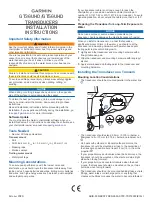
AC4868 868 MHz Transceiver
User’s Manual
Americas: +1-800-492-2320 Option 3
21
Laird Technologies
Europe: +44-1628-858-940
Hong Kong: +852 2923 0610
www.lairdtech.com/ramp
the OEM Host can prevent the transceiver from sending it data by disabling RTS (logic High). Once RTS is
enabled (logic Low), the transceiver can send packets to the OEM Host as they are received.
Note: Leaving RTS disabled for too long can cause data loss once the transceiver’s 256 byte receive buffer
fills up.
Test / 9600 Baud
When pulled logic Low before applying power or resetting, the transceiver’s serial interface is forced to a
9600, 8-N-1 (8 data bits, No parity, 1 stop bit). To exit, the transceiver must be reset or power-cycled with Test
pin logic High. This pin is used to recover transceivers from unknown baud rates only. It should not be used in
normal operation. Instead the transceiver Interface Baud Rate should be programmed to 9600 baud if that
rate is desired for normal operation.
Engineer’s Tip: Laird Technologies does not recommend permanently grounding the Forced_9600 pin.
This mode was intended for recovering transceivers from unknown settings and was not
intended for use in real-time communications.
UP_Reset
UP_Reset provides a direct connection to the reset pin on the AC4868-250 microprocessor and is used to
force a soft reset. For a valid reset, reset must be asserted High for a minimum of 11ms.
Command / Data
When logic High, the transceiver interprets incoming OEM Host data as transmit data to be sent to other
transceivers and their OEM Hosts. When logic Low, the transceiver interprets OEM Host data as command
data.
AD In and DA Out
AD In & DA Out can be used as a cost savings to replace Analog-to-Digital and Digital-to-Analog converter
hardware. Read this pin locally with the Read ADC command in the On-the-Fly Control Command Reference.
DA Out is an unbuffered, high impedance output and MUST be buffered by the OEM Host when used.
In Range
Reports logic Low when a Client transceiver is in range of a Server radio operating on the same RF Channel
and system ID. If a Client cannot hear a Server for the amount of time defined by Range Refresh, it will drive
In_Range High and enter search mode looking for a Server. When a server is detected, In_Range will be
asserted Low. In_Range will always report Low on Server transceivers.
















































